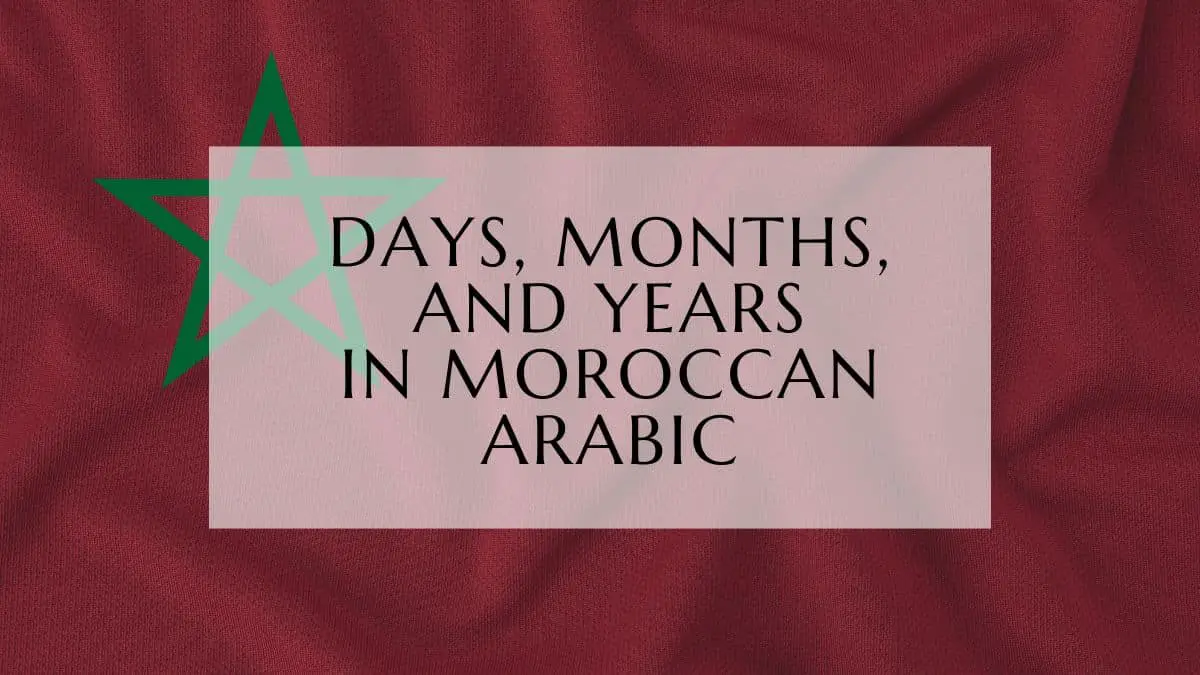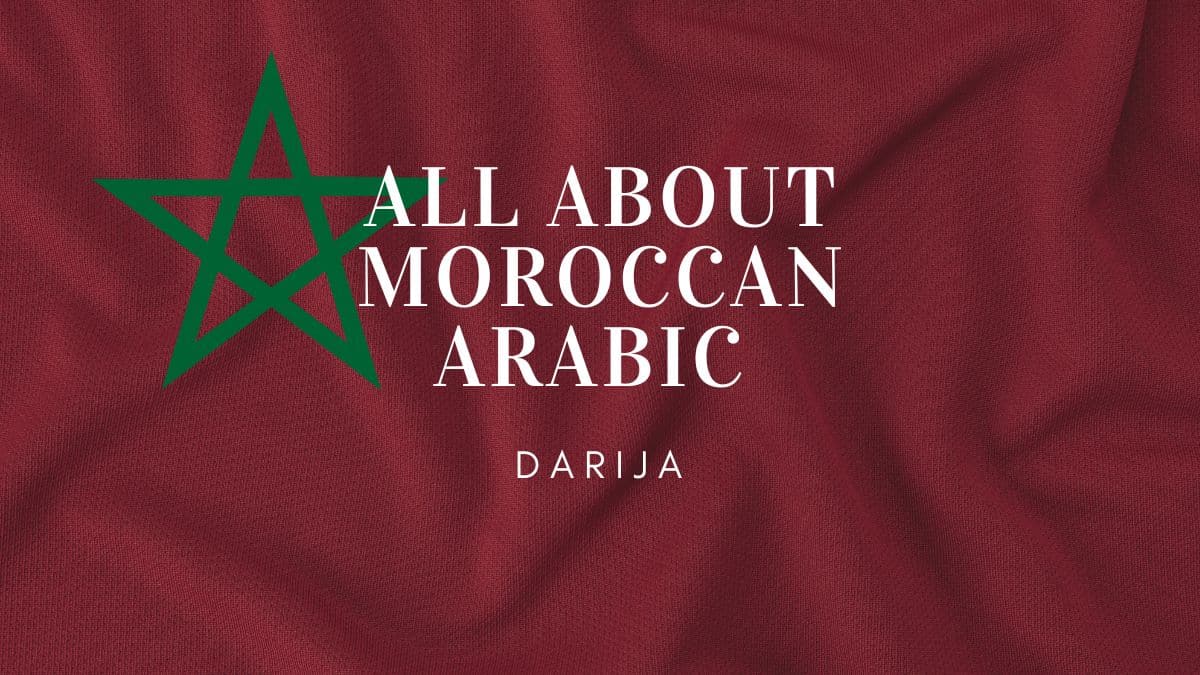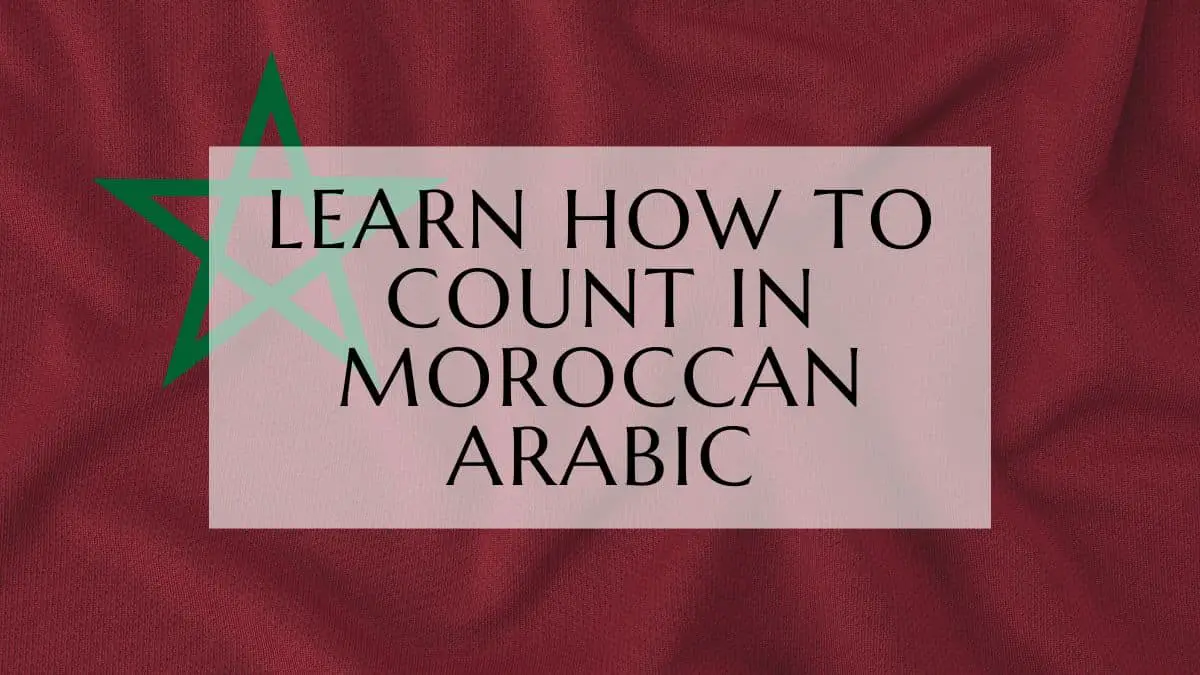In this lesson, you will learn to talk about days, months, and years in Moroccan Arabic (with audio), and you will learn how to count them as well.

Days, Months, and Years in Moroccan Arabic
Week Days In Moroccan Arabic
| English | Transcribed Moroccan Arabic | Using Arabic Alphabet |
| Monday | Ttnin | التّنِين |
| Tuesday | Ttlat | التّلات |
| Wednesday | Larbe3 | لاربْع |
| Thursday | Lkhmis | لْخميس |
| Friday | Ejjem3a | الجّمْعة |
| Saturday | Essebt | السّبْت |
| Sunday | Lhed/L7ed | لحد |
Note: in Darija the days are used with the definite article, in written form, you may also write: tnin, tlat, larbe3, lkhmis, jem3a, sebt, lhed/l7ed (colored ones can not be used without the definite article)
If you’re familiar with Standard Arabic, you may notice that the weekdays aren’t very different from the Darija ones.
Months In Moroccan Arabic
| English | Transcribed Moroccan Arabic | Using Arabic Alphabet |
| January | Yanayer | يناير |
| February | Febrayer | فبراير |
| March | Mars | مارس |
| April | Abril | أبريل |
| May | May | ماي |
| June | Yonyo | يونيو |
| July | Yolyoz | يوليوز |
| August | Ghosht | غشت |
| September | Shutanbir | سبتمبر |
| October | October | أكتوبر |
| November | Nowanber | نونبر |
| December | Dojanber | دجنبر |
In Morocco, you will hear people also say numbers instead of months, for example: shhar wahed (January, literally month one), shhar joj (February, literally month two), so it’s a good thing to keep in mind.
Lunar Calendar (Hijri)
It’s also useful to learn the Hijri calendar, just notice that in this case, we don’t use numbers to talk about them:
| English | Transcribed Moroccan Arabic | Using Arabic Alphabet |
| Muharram | Muharram | محرم |
| Safar | Safar | صفر |
| Rabi’ al-awwal | Rabi3 el2awwal | ربيع الأول |
| Rabi’ al-thani | Rabi3 ettani | ربيع التاني |
| Jumada al-awwal | Jomada l ula | جمادى الأولى |
| Jumada al-thani | Jomada ttanya | جمادى التانية |
| Rajab | Rajab | رجب |
| Sha’ban | She3ban | شعبان |
| Ramadan | Remdan | رمضان |
| Shawwal | Shewwal | شوال |
| Dhu al-qi’dah | Du lqi3da | دو القعدة |
| Dhu al-Hijjah | Du lhijja | دو الحجة |
Note: you can practice what you’ve learned here, and learn how to pronounce each of the words in our Memrise course here, don’t know how to use the platform or sign up? we’ve got you covered in this easy-to-follow tutorial here.
Counting Days, Months, And Years In Darija
Counting Days In Darija
| English | Transcribed Moroccan Arabic | Using Arabic Alphabet |
| 1 day | Nhar/yom | نهار/يوم |
| 2 days | Yomin | يومين |
| 3 days | Tlt yam | تلتيام |
| 4 days | Rb3 yam | ربعيام |
| 5 days | Khmsiyam | خمسيام |
| 6 days | Settiyam | ستيام |
| 7 days | Seb3iyam | سبعيام |
| 8 days | Temniyam | تمنيام |
| 9 days | Tes3iyam | تسعيام |
| 10 days | 3eshriyam | عشريام |
| 11 days | Hdasher yom | حضاشر يوم |
| 12 days | Tnasher yom | تناشر يوم |
| 13 days | Tlettasher yom | تلطاشر يوم |
| 14 days | Rbe3tasher yom | ربعطاشر يوم |
| 15 days | Khmestasher yom | خمسطاشر يوم |
| 20 days | 3eshrin yom | عشرين يوم |
| 21 days | Wahed w3eshrin yom | واحد و عشرين يوم |
From 21 on, you will use numbers normally and add yom
Note: you may hear people also hear people say L instead of R (Tnashel yom instead of tnasher yom, for example)

Counting Months In Darija
| English | Transcribed Moroccan Arabic | Using Arabic Alphabet |
| 1 month | Shher | شهر |
| 2 months | Shehrin | شهرين |
| 3 months | Tlt shhor | تلت شهور |
| 4 months | Rb3 shhor | ربع شهور |
| 5 months | Khms shhor | خمس شهور |
| 6 months | Sett shhor | ست شهور |
| 7 months | Seb3 shhor | سبع شهور |
| 8 months | Temn shhor | تمن شهور |
| 9 months | Tes3 shhor | تسع شهور |
| 10 months | 3eshr shhor | عشر شهور |
| 11 months | Hdasher shher | حضاشر شهر |
| 12 months | Tnasher shher | تناشر شهر |
Counting Years In Darija
| English | Transcribed Moroccan Arabic | Using Arabic Alphabet |
| 1 year | 3am | عام |
| 2 years | 3amin | عامين |
| 3 years | Tlt snin | تلت سنين |
| 4 years | Rb3 snin | ربع سنين |
| 5 years | Khms snin | خمس سنين |
| 6 years | Sett snin | ست سنين |
| 7 years | Seb3 snin | سبع سنين |
| 8 years | Temn snin | تمن سنين |
| 9 years | Tes3 snin | تسع سنين |
| 10 years | 3eshr snin | عشر سنين |
| 11 years | Hdasher 3am | حضاشر عام |
| 12 years | Tnasher 3am | تناشر عام |
| 13 years | Tlettasher 3am | تلطاشر عام |
| 14 years | Rbe3tasher 3am | ربعطاشر عام |
| 15 years | Khmestasher 3am | خمسطاشر عام |
| 20 years | 3eshrin 3am | عشرين عام |
| 21 years | Wahed w3eshrin 3am | واحد و عشرين عام |
Moroccan Arabic: Time Expressions Study Guide
Questions
- What is notable about the use of the definite article with days of the week in Darija?
- How are the months often referred to in casual Moroccan conversation? Provide an example.
- What is the key difference between the Gregorian calendar months and the Hijri calendar months as they are referred to in Darija?
- Provide the Darija terms for “one day,” “two days,” and “three days,” noting any patterns.
- How do you express “21 days” in Darija?
- What alternative pronunciation might you hear for the Darija word for “12 days”?
- What is the pattern for counting months in Darija? Provide examples for three, four, and five months.
- What is the Darija term for “year”?
- Describe the pattern for counting years in Darija, providing examples for “three years,” “four years,” and “five years.”
- How is the number “21” incorporated when expressing “21 years” in Darija?
Short Answer Key
- In Darija, the definite article (equivalent to “the”) is used with days of the week, even if the day hasn’t been mentioned previously.
- In casual Moroccan conversation, months are often referred to by their numerical order. For example, January is “shhar wahed” (month one) and February is “shhar joj” (month two).
- Gregorian calendar months are referred to by their specific names in Darija (e.g., Yanayer, Febrayer), while Hijri months are not assigned numerical values in conversation (e.g., Muharram, Safar).
- “One day” is “nhar/yom,” “two days” is “yomin,” and “three days” is “tlt yam.” The pattern involves a number combined with a variation of “day” (yam).
- “21 days” in Darija is “wahed w3eshrin yom” (literally “one and twenty day”).
- An alternative pronunciation for “12 days” in Darija is “tnashel yom,” replacing the “r” sound in “tnasher” with an “l.”
- Counting months in Darija follows a pattern using a number and the word “shhor” (month): “tlt shhor” (three months), “rb3 shhor” (four months), “khms shhor” (five months).
- The Darija term for “year” is “3am.”
- The pattern for counting years in Darija combines a number with “snin” (years), for example: “tlt snin” (three years), “rb3 snin” (four years), “khms snin” (five years).
- When expressing “21 years” in Darija, you use the structure “wahed w3eshrin” (one and twenty) followed by “3am” (year): “wahed w3eshrin 3am.”
Happy learning!
Oualid Cheddadi is the founder of Lingualid, a platform that inspires independent language learners worldwide, regardless of the language they are learning. The name “Lingualid” is derived from the Portuguese word for “language,” “língua,” and the last three letters of Oualid’s name, “Lid.”



